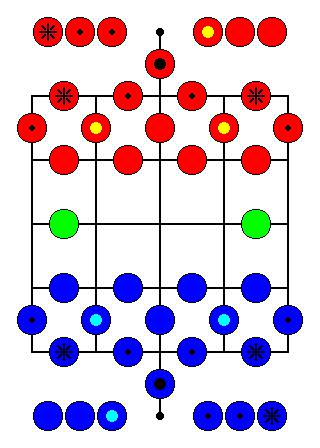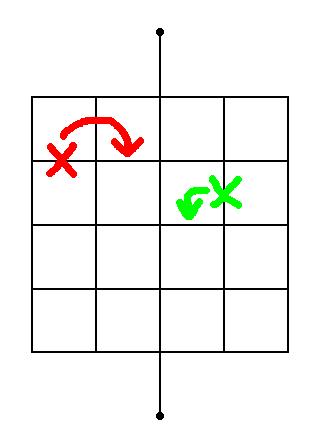Border Wars
By Jared B. McComb

|
IntroductionBorder Wars is a game played on the board at left. The game is played on the line segments of the board. There are 20 horizontal and 22 vertical segments; thus, there are 42 spaces altogether. The game is played between two players, Red and Blue. The dots on either end of the board represent capital cities; these will be explained below. This game got its name because it resembles a war played entirely on the borders of numerous areas. |

|
SetupThe opening setup is shown here. The pieces not on any segments are considered to be 'reserve' or 'in-hand' pieces; they are shown here in this way for illustrative purposes only. The Green pieces are neutral, and the other pieces are either Red or Blue. The non-Green pieces are actually double-sided, like Othello pieces, so they can be used by either player. (They are marked identically on both sides.) Here are the types of pieces:
Generals (have a large black dot)
The green pieces are therefore pawns. |

|
DefinitionsThere are two types of move used in this game. The first, crosspoint (shown in RED), is defined as movement between two adjacent segments that are part of the same line - it crosses the point of intersection with the perpendicular lines. The second, crosscorner (shown in GREEN), is defined as movement between two adjacent perpendicular segments - it crosses the corner of the adjacent cell. There are two types of captures in this game. The first is called destructive capture, and is the same as standard Chess capture; the piece captured is permanently removed from play. The second is called passive capture, and is similar to Shogi capture; the piece captured is flipped over and entered into the capturing player's reserve. The spaces that are adjacent to the capitals, and that the generals start the game on, are called capital roads. These have special properties when relating to certain pieces. The value of a piece is the number of points the piece is worth when scoring, or when exerting influence on a neutral pawn (see below). |
Rules
The objective of this game is to capture your opponent's general, whether with destructive or passive capture. You also win if your opponent is left vanquished (see below). The Blue player has the first move. On your turn, you may move any of your pieces, or a neutral pawn that is under your influence (see below). The 50-move rule of Chess applies to this game, and three-time repetition is a loss for the player who makes the third one.
Piece Moves
The Pawns may move one space crosspoint or crosscorner. They use destructive capture and are worth one point each. They are the most numerous and expendable pieces. Pawns don't promote.
The Blockades may move any distance crosspoint or crosscorner. They may not capture at all, and they can only be captured by the opposing general or diplomats. They are worth three points each. They serve the important purpose of annoying the opponent. A Blockade can reach any space on an empty board in two moves (I leave the simple proof to the reader).
The Guards may move any distance crosspoint or one space crosscorner. They use destructive capture. They are worth two points each. They can get to any space on an empty board in three moves (I leave the simple proof to the reader).
The Diplomats may move one space crosspoint or any distance crosscorner. They use passive capture. They are worth three points each. If a Diplomat moves onto the opponent's capital road, they immediately convince all the opponent's reserve to switch sides, and their side takes ownership of them. A Diplomat can reach any space on an empty board in three moves, and can usually get there in two (again, I leave the simple proof to the reader).
The Generals may move one space crosspoint or crosscorner. They use passive capture. They are worth five points each. If a General moves onto the opponent's capital road, they discuss peace with the other side (successfully) and the game is drawn. It is always necessary to keep your General out of check.
Neutral Pieces
The neutral pieces are Pawns, and thus may move and capture (destructively) one space crosspoint or crosscorner. In order to move a neutral pawn, you must have a greater total value of adjacent pieces (crosspoint or crosscorner) than your opponent - this is known as exerting influence. If both players have equal non-zero scores when pertaining to a neutral piece, either player may move it, but not capture with it. Neutral pieces may be captured, but this is always a destructive capture, regardless of the piece that captured it.
Capital Roads
As mentioned above, the capital roads have certain properties when occupied by certain enemy pieces. In addition, when a player's capital road becomes empty, they may place one of their reserve pieces on it. This counts as a turn.
Vanquish
A player is considered vanquished and loses the game if all of the following conditions apply:
- They have no reserve left.
- They have no diplomats left.
- They have less than ten points of pieces left (including their General).
- Both neutral pieces have been captured.
From these conditions and the rules, it can be safely inferred that a bare General is impossible. Note that rule 3 could be reworded as follows: "They have five or fewer points of pieces left (not including their general)."
Strategy
One of the first things you should do is try to mobilize all three of your diplomats - they are easily the most powerful pieces in the game and can be used to convert your opponent's pieces to your side. Keep your capital road protected from enemy diplomats! And while we're on the subject of diplomats, try to capture them with your own diplomats (and your general). Try to keep at least one piece (usually a pawn or blockade) in your reserve at all times, to protect from vanquish. There are no leaping pieces (like knight equivalents) in this game, so it is possible to block all ranged attacks.
Variants
Border Wars Chess: There are no reserves, no neutral pieces, no vanquish, and no passive captures.
Border Wars Shogi: The reserves start out empty, there are no neutral pieces, no vanquish, and all captures are passive.
Border Wars Xiang-Qi: Play as Border Wars Chess, but the blockades are replaced by cannons. They have the same move, but can capture in the same manner as a Xiang-Qi cannon. This variant is much more violent than any of the others.
Computer Play
An implementation of Border Wars Chess has been written for Zillions of Games. You can download it here:
Credits
This game was written by Jared B. McComb as an entry to the 42 squares contest hosted by Chessvariants.com. It was inspired mostly by Western Chess, Shogi , and Xiang-Qi). I also borrowed a rule from Byzantine Chess. I would especially like to thank Mr. Bodlaender for giving me an excuse to stick in as many 42s as I could think of (there are 42 spaces and 42 pieces, and each player's army starts out with 42 points).
Please send all questions, comments, constructive criticisms, better diagrams, reports of other 42s, etc., to
Written by Jared B. McComb. HTML Conversion by Peter Aronson.
WWW page created: February 2nd, 2002.
